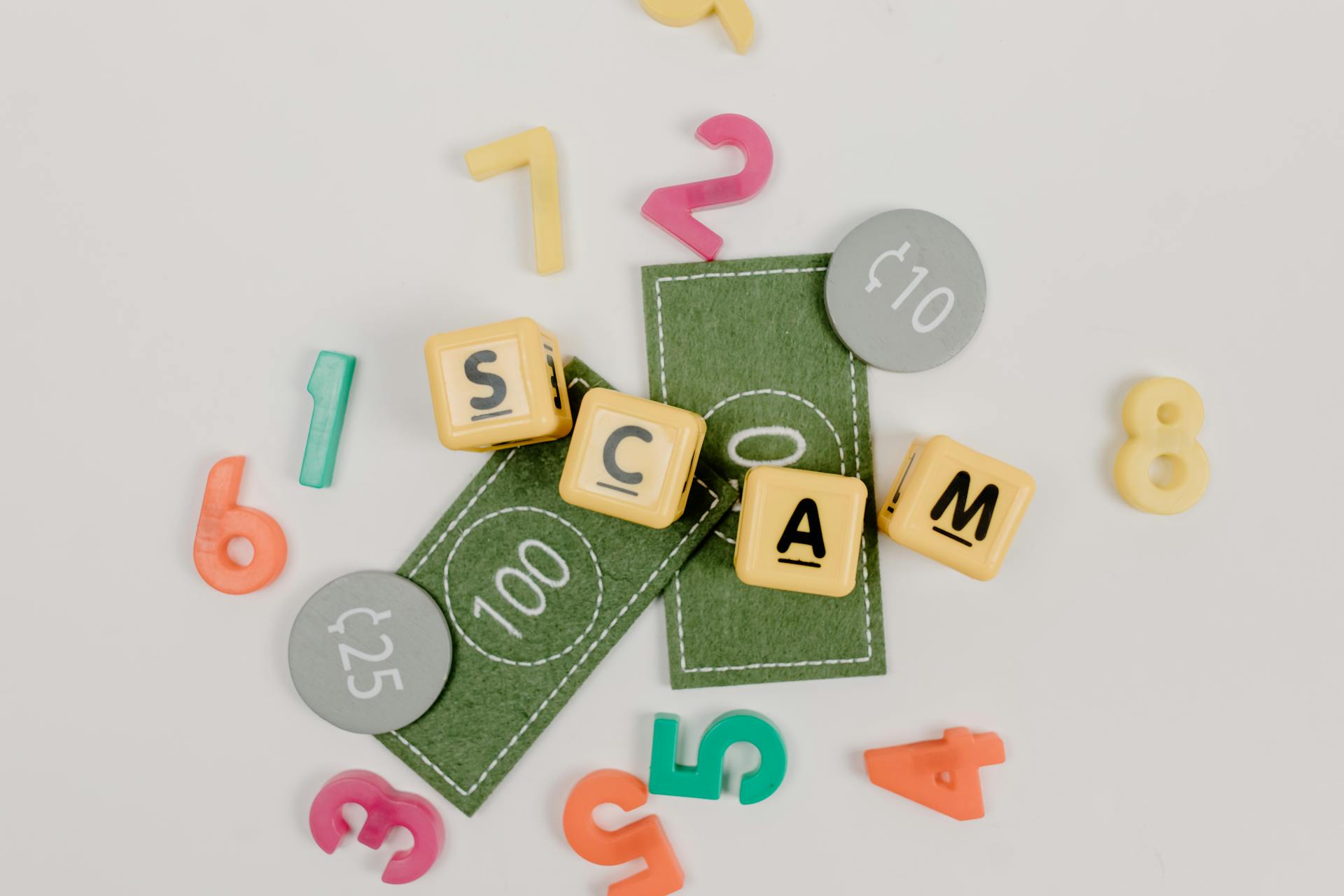
In Canada, bank institution numbers are a crucial piece of information that helps identify financial institutions. There are 85 unique bank institution numbers assigned to financial institutions in Canada.
These numbers are assigned by Payments Canada, a non-profit organization that oversees the Canadian payment system. Payments Canada ensures that all financial institutions have a unique bank institution number.
A bank institution number is used to identify the institution that holds your account, not the account itself. This is why you may see your bank's institution number on your cheques or account statements.
Worth a look: Rbc Canada Routing Number
Finding Your Bank Institution Number
Finding your bank institution number is easier than you think. You can find it on your paper or electronic bank statement.
If you don't have a cheque, don't worry, you can still find your institution number. Look for it on your online banking portal, which will often have your transit/branch and institution number or provide a digital cheque with the information.
Additional reading: Financial Institution Routing Transit Number
You can also call or visit your nearest bank branch and ask for the number. Bank staff will be happy to help you.
Alternatively, you can search online for a comprehensive list of bank institution numbers.
The institution number is usually located at the bottom of a cheque, along with the transit number and account number.
If this caught your attention, see: Financial Institution Routing Number
Canadian Bank Institution Numbers
A Canadian bank institution number is a three-digit number that identifies a specific bank, not a bank branch. This number is unique to each bank and is part of the routing number.
In Canada, each bank has its own institution number. For example, the Royal Bank of Canada (RBC) has an institution number of 003, while the Bank of Montreal (BMO) has an institution number of 001.
Here's a list of some well-known Canadian banks and their institution numbers:
These institution numbers are used in combination with the transit number to make up the routing number, which is needed for bank transactions.
List of Canadian Financial Entities

A bank institution number is a three-digit number that refers to a specific bank, not a bank branch. It's a unique identifier for the corporation itself.
In Canada, you can find this number on your cheque, usually starting from the bottom left. It's the next three numbers after the transit number.
Here's a list of some well-known Canadian banks and their institution numbers:
If you bank with one of these institutions, you can easily find your institution number on your cheque.
Canadian Branch & Transit Codes
Canadian Branch & Transit Codes are a crucial part of understanding your bank account information. A transit number is a 5-digit number that refers to your specific bank branch.
For example, if you bank with RBC, your institution number is 003, but your transit number will depend on which branch your account is held with. You can find it on your cheque, deposit slip, bank statement, or through your RBC online bank account.
Intriguing read: Td Bank Transit Code
The process for finding your routing number with CIBC is the same as with other financial institutions. You first need your institution number, which is 0010 for CIBC. From there, you can find your transit number and get your CIBC routing number.
Here's a list of some common Canadian banks and their institution numbers:
It's worth noting that these institution numbers are the same for all branches of the bank, credit union, or institution.
Canadian Banks
Canadian banks have their own unique institution numbers, which are a three-digit code that identifies the bank itself, not a specific branch. For example, the institution number for Royal Bank of Canada (RBC) is 003.
The institution number for Bank of Montreal (BMO) is 001, for Bank of Nova Scotia (Scotiabank) it's 002, and for Toronto-Dominion Bank (TD) it's 004. These numbers can be found online or on your bank's website.
You can also find your bank's institution number by looking at your cheque, deposit slip, or bank statement. Alternatively, you can call your bank or check your online banking portal.
Related reading: What Is a Bin Number on a Credit Card
Here is a list of institution numbers for some of the most recognized Canadian banks:
These institution numbers are used in conjunction with the transit number to create the routing number, which is needed for bank transactions.
Using Bank Institution Numbers
You can find your bank institution number through online banking or by looking at the bottom of your cheque. To find it through online banking, simply log in, choose your account, and go to the ‘Select an Action’ menu, then choose ‘Direct Deposit Form’ and go to the ‘Deposit Form’ tab.
Alternatively, you can look at the bottom of your cheque to find your financial institution number. It will be the third string of numbers in the sequence of numbers at the bottom of your cheque.
If you're still unsure, you can refer to this list of common Canadian bank institution numbers:
Direct Deposit
To set up a direct deposit, you'll need to find your branch transit, institution, and account numbers through online banking. Log in to your account, choose the account you want to use, and go to the 'Select an Action' menu to find the 'Direct Deposit Form' and 'Deposit Form' tab.

The routing number is a crucial part of the direct deposit process, but it's only half the information needed. The other half is your account number, which is a unique 7 to 12 digit number that identifies your account.
To access your routing number, you can use a direct deposit form or a void cheque, both of which contain the same information. This will give you the routing number you need to set up a direct deposit.
Your account number is essential for direct deposit, and it's used in combination with your routing number to make deposits or withdrawals to or from your account.
Consider reading: Rules on Safety Deposit Boxes
How a Cheque Works
To use a bank institution number on a cheque, you'll need to understand how a cheque works. A cheque must be filled out correctly and signed before the transaction will be processed.
The cheque number, transit number, and institution number are all important details to note. The institution number is usually three numbers, such as '002' for Scotiabank or '623' for EQ.
A physical cheque isn't much different from processing a direct deposit, but it can take some time to process the transaction. The funds don't actually leave your account for a few days.
Financial institutions use magnetic ink character recognition to validate the cheque and streamline the process of clearing a cheque. This reduces the potential for fraud and makes the process more efficient.
For another approach, see: Bank Draft vs Bank Cheque
Understanding Bank Institution Numbers
A bank institution number is a unique three-digit code assigned to a bank or financial institution to identify them. It's a crucial piece of information used for various transactions.
To find your bank's institution number, you can look it up online, check your cheque, or use your bank's app or online banking portal. Alternatively, you can call your bank for assistance.
The institution number is used in conjunction with the transit number and account number to create a routing number, which is essential for processing cheque and electronic transactions. This includes direct deposits, digital cheques, and recurring loan and bill payments.
Here's a breakdown of the components of a bank account number:
- The institution number - three digits - identifies your bank.
- The transit number - five digits - shows which branch you opened your account at.
- The account number - seven to twelve digits - identifies your individual account.
What is a Number?
A bank institution number is a unique three-digit code that identifies a specific bank. It's an important part of your banking information.
The institution number is used to process transactions such as funds transfers, direct deposits, and digital cheques. This is because it helps banks identify the correct account to debit or credit.
A bank institution number is a three-digit number, not to be confused with a transit number which is five digits. The transit number shows which branch you opened your account at.
Here's a breakdown of the different parts of a bank routing number:
- Institution number: three digits, identifies your bank
- Transit number: five digits, shows which branch you opened your account at
- Account number: seven to twelve digits, identifies your individual account
What Is a Financial Entity?
A financial entity, in the context of bank institution numbers, refers to a specific bank or institution. This entity has its own unique three-digit number, also known as a financial institution number or bank institution number.
This number is used to identify the bank or institution, and it's the same for all branches of the bank or institution. You can find this number on a cheque linked to your account, as well as in your direct deposit information.
A financial entity can be a bank, credit union, trust company, or any other type of financial institution. All of these institutions have their own unique financial institution number.
Here's a breakdown of what you can find on a cheque:
- Cheque number: the first set of numbers
- Transit number: the next five numbers
- Institution number: the next three numbers
For example, if you bank with Scotiabank, you'll see '002', and if you bank with EQ, you'll see '623'.
You can look up your bank's institution number online or by calling your bank. Many sites have a list of all Canadian bank institution numbers, or you can find it on your cheque or through your bank's app or online banking portal.
You might enjoy: How to See Go to Bank Virtual Card Number
Frequently Asked Questions
What is bank institution 004?
Bank institution 004 refers to the Toronto-Dominion Bank. It's a major Canadian bank with a wide range of financial services.
What banking institution number is 016?
The institution number 016 is associated with HSBC. This number is used for various banking purposes, including direct deposit and online banking.
What is an institution number in USA?
An institution number is a 3-digit code that identifies your bank in the USA. It's a crucial part of your bank's routing number, which helps direct transactions to the right account.
Sources
- https://wise.com/ca/bank-codes/transit-number/institution-number
- https://www.bankrouting.ca/financial-institution-numbers
- https://www.meridiancu.ca/bank-anywhere/how-to-find-your-branch-transit-institution-and-account-number
- https://www.springfinancial.ca/blog/save-invest/what-are-canadian-bank-institution-routing-numbers
- https://loanscanada.ca/banking/canadian-bank-institution-numbers/
- https://www.forbes.com/advisor/ca/banking/what-is-a-bank-institution-number/
Featured Images: pexels.com


